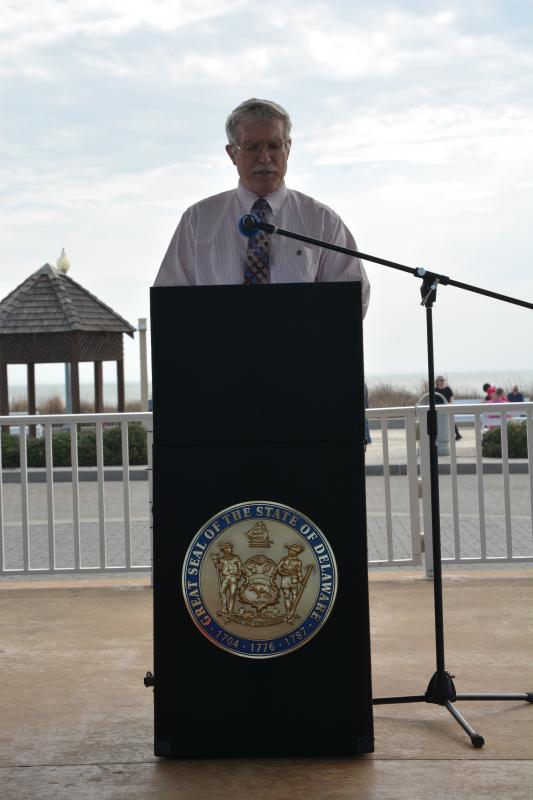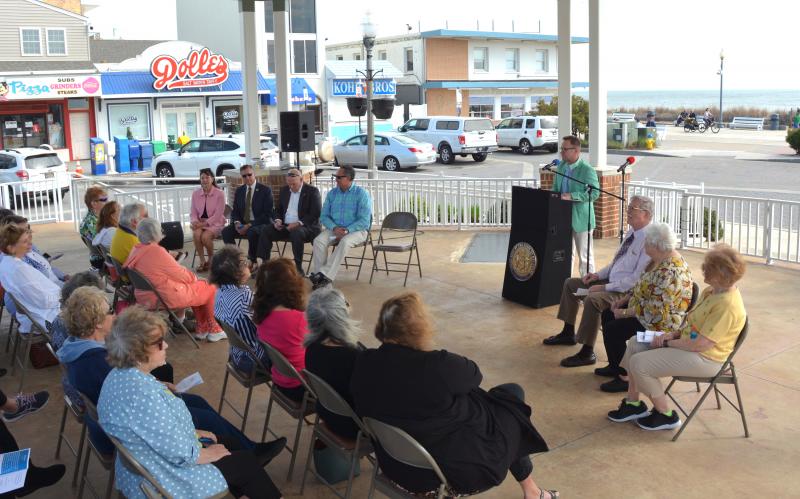Rehoboth’s surf safety line gets Boardwalk historical marker

While the bathing suit manufacturers of today have embraced the reduce portion of reduce-reuse-recycle, that wasn’t the case for bathing suits in the early 20th century.
Particularly for women, the wool bathing suits of the time covered most of their bodies and became heavy when wet, making it difficult to exit the water. In Rehoboth Beach, surf safety lines were installed to facilitate escaping the surf.
A new historic marker on the Boardwalk recognizes the importance of the safety line. Unveiled April 14, the marker was the idea of the Village Improvement Association and done in conjunction with the Delaware Public Archives’ Historical Marker Program.
The historical marker was the first dedicated in 2022 by and the fifth spurred by the VIA. There was a brief ceremony before the big reveal.
VIA President Ann Sebastian and VIA Past President Carole Suchanek spoke on behalf of the VIA. The surf line effort was initiated under Suchanek.
“We’re getting to be pretty good at this,” said Suchanek, who was handing out postcards with a picture of the surf line and information from Delaware Public Archives saying the line was installed by the newly formed VIA after the group convinced the town fathers it was needed.
Mayor Stan Mills recognized the civic organization for having initiated the installation of five markers. That’s more than any other group in Delaware, he said, also encouraging members of the public to go see a wall-sized photo of the surf safety line in action at the entrance of city hall.
The other historical markers installed at the request of the VIA are at the Rehoboth Beach Public Library, the lighthouse by the traffic circle, the children’s fishing pier at Lake Gerar and the VIA’s clubhouse on Grenoble Place.
Speaker of the House Rep. Pete Schwartzkopf, D-Rehoboth Beach, was a lifeguard in Bethany Beach as a young man. He said he could imagine trying to pull someone out of the rough surf with a soaking-wet wool bathing suit. Those bathing suits weighed 30 pounds, he said.
Schwartzkopf said he appreciated the hard work of the VIA for the past 100 years.
“Keep putting markers up and we’ll keep paying for them,” said Schwartzkopf.
Sen. Ernie Lopez, R-Lewes, commended the VIA for going above and beyond in terms of research. Also, he said, he was happy to help with funding the sign, because he’s learned over the years to do what the VIA tells him to do.
The marker reads: “When at the beach, women of the early 20th century wore woolen bathing attire that covered most of their bodies. When wet, the suits were heavy, and it became difficult to leave the surf and get back onto the beach without help. The women of the Village Improvement Association solved this by funding surf safety lines that were anchored in the sand and attached to a buoy offshore. When ready to leave, bathers could hold onto the line and pull themselves out of the water to the shore.”



























































